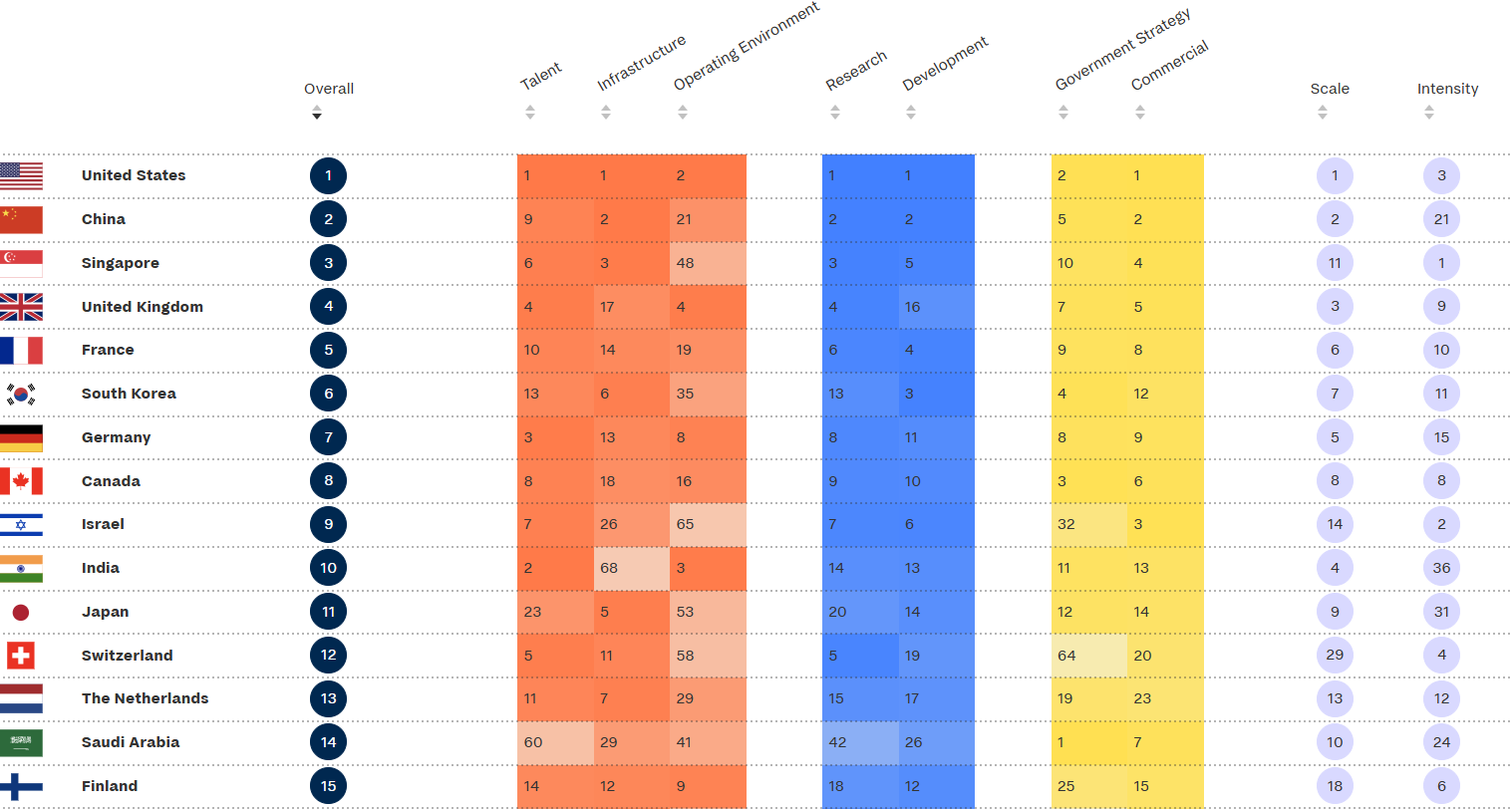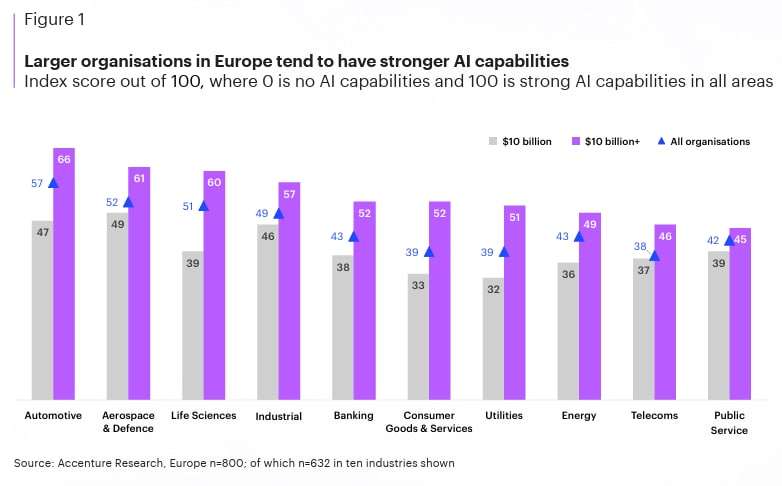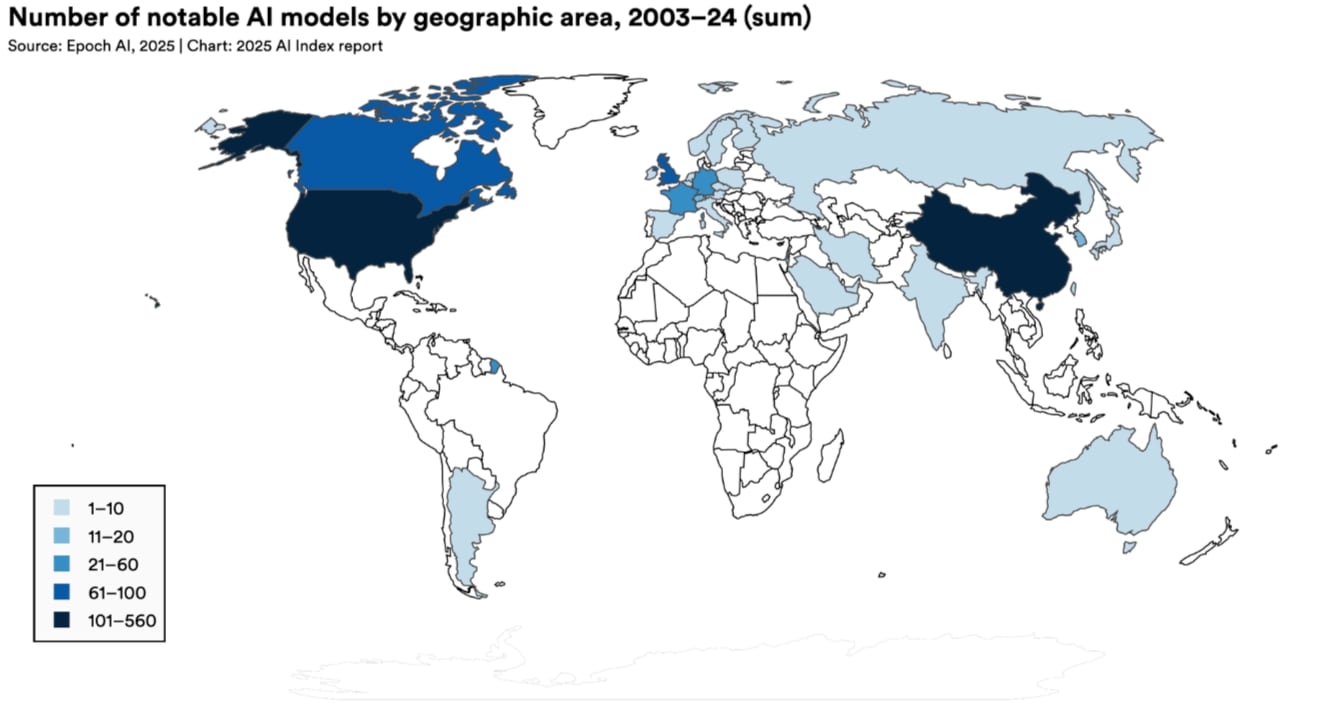
How can Europe’s businesses catch up in the AI race? Image: REUTERS/Dado Ruvic/Illustration
This article is part of:Centre for AI Excellence and Centre for Regions, Trade and Geopolitics
- Europe lags behind the US in AI adoption, with varying progress across EU countries, despite the European Commission's efforts to foster an environment for AI to thrive.
- Top European AI adopters like Denmark and the Nordic countries focus on innovating on the back of existing AI models, fostering collaboration and creating supportive regulations.
- Supportive regulation, targeted assistance for SMEs and resilient national ecosystems were identified as key priorities for boosting AI adoption in Europe by leaders at the World Economic Forum's summer Davos.
Artificial Intelligence has countries the world over vying for supremacy – or at the very least a slice of the AI pie.
The US has led the way with key innovations, such as AI microchips and the large language models that form the foundations of generative AI. In something akin to the 1960s space race, China has been following closely in the US’s footsteps. Yet, the rest of the world is in catch-up mode, including Europe.
A study by Accenture reveals that European AI adoption is lagging behind the US. More than half of large European organizations (56%) “have yet to scale a truly transformative AI investment”, the consultancy states.
And this race is being complicated by growing questions over the return on investment from the massive funds being spent, so how can Europe's businesses catch up?

Policy support for European AI to thrive
In the wake of last year’s Draghi report, there has been a raft of policy initiatives aiming to push Europe to the cutting edge of AI, raising competitiveness and boosting GDP growth.
The EU AI Act of 2024 was the world’s first comprehensive AI law, providing harmonized rules and an AI Code of Practice. It emphasizes responsible AI development, strict data security and user privacy, supported by market monitoring, enforcement and governance bodies like the European Artificial Intelligence Board and AI Office.
Next, the AI Continent Action Plan, launched in April 2025, set out Europe’s ambition to be a global AI leader, promoting AI adoption in strategic sectors across the bloc. It includes a range of measures to scale AI infrastructure and speed significant innovations in areas such as healthcare, biotech and robotics with the help of so-called “AI gigafactories” – large-scale supercomputing centres dedicated to AI development.
The plan also aims to establish a level playing field for access to quality data, mobilize investment and support SMEs and startups with innovation programmes and training to strengthen AI talent pools.
These initiatives are being followed by a range of supporting policies either under consultation or expected to be drafted in the course of this year, including the Apply AI Strategy, which aims to accelerate AI integration and digital sovereignty – reducing reliance on foreign technology.

Overcoming the AI lag
Creating an environment for European businesses to embrace AI and thrive is urgently needed, especially considering the investments made by other countries. In 2024, the US alone introduced 59 AI-related federal regulations, more than double the number in 2023, according to Stanford University’s 2025 AI Index Report.
Legislative activity was also significantly up in another 75 countries, and governments worldwide have been investing at scale, including €109 billion committed by France, $100 billion by Saudi Arabia and a $47.5 billion semiconductor fund launched by China.
In addition, private investment in the US reached over $109 billion last year, some 12 times China’s investment and 24 times that of the UK, Stanford University reports. This surge in spending has led some commentators to warn of a potential investment bubble that could go wrong if widespread adoption is lower than expected. It also underscores a dual risk for Europe – not only falling behind technologically, but also missing out on a historic wealth-creating wave.
Since 2003, the United States has produced more AI models than any other major country, including the UK, China and Canada. In 2024 alone, 40 influential AI models came from the US, compared with 15 from China and three from France.
What is more, Accenture’s research found that while 48% of Europe’s largest organizations say they have scaled a strategic AI initiative, only 31% of small and medium-sized businesses have achieved this.

AI in Europe is developing at different rates
The European Commission’s regulatory push has been criticised for overregulation. However, one of the challenges is that, unlike the US, Europe is fragmented in its progress with AIs, according to data from Eurostat. Therefore, harmonizing, creating a level playing field and bringing the bloc’s AI infrastructure and activities together is essential.
A study by the Commission revealed that, across the EU, only 13.5% of enterprises were using AI technologies as of 2024.
However, in Denmark, the percentage is more than double that, at nearly 28%. Other Nordic countries and Benelux followed with substantially higher-than-average AI deployment.
In comparison, only 3% of Romania's enterprises use AI. Even in France, the European leader in developing AI models, less than 10% of businesses used AI technology last year.
What can countries whose AI progress is slower learn from those who are leading in AI deployment?

What are Europe’s top AI performers doing right?
Compared to the US and China, the Nordics are small individual players. But as the European Centre for International Political Economy (ECIPE) points out, these countries have realized that they cannot compete on scale, so rather than create their own AI models, their focus has been to innovate using existing ones.
With few large incumbent organizations, the Nordics have prioritized new technological innovators and opened their markets to international competition, creating an environment that fosters the growth of these young companies. These countries are also well known for their commitment to collaborative practices and open innovation, as the ECIPE’s report reminds.
Another top AI performer, Belgium, is also relying heavily on collaboration in the AI arena. Some 90% of Belgian companies state the importance of working with start-up companies to accelerate their AI development.
Regulation is vital to creating an environment where innovation can thrive. For example, Denmark’s national Strategy for AI, launched in 2023, prioritizes a responsible adoption of AI. €200 million has been dedicated to research and development, with a focus on healthcare, education and sustainability. Adding to a broad framework of AI regulation, Denmark is currently in the process of updating its copyright law to protect individuals against AI-generated deepfakes.

Bridging the gaps in AI infrastructure and adoption
Sweden, however, has a more complex relationship with AI adoption. Despite ranking high in AI adoption among businesses according to Eurostat, the country places only 25th in the Global AI Index out of more than 80 countries worldwide. Moreover, despite being one of Europe’s most developed nations, Sweden has one of the bloc's least developed AI and supercomputing infrastructures. In response, the country has ramped up efforts in recent months, securing significant public and private investments, including funding for building advanced AI capabilities.
This case highlights where Europe’s focus may need to shift – specifically, towards developing robust local infrastructure.
Karim Nouira, CEO of Superintelligence Computing Systems (SICS), a Swedish robot-brain startup, told Computer Weekly that if Europe wants to win the AI race, it must stop copying the United States. He added that Europe should move away from developing more large language models and other types of AI that already exist in abundance.
- How is the World Economic Forum creating guardrails for Artificial Intelligence?
In response to the uncertainties surrounding generative AI and the need for robust AI governance frameworks to ensure responsible and beneficial outcomes for all, the Forum’s Centre for the Fourth Industrial Revolution (C4IR) has launched the AI Governance Alliance.
The Alliance unites industry leaders, governments, academic institutions, and civil society organizations to champion responsible global design and release of transparent and inclusive AI systems.
This includes the workstreams part of the AI Transformation of Industries initiative, in collaboration with the Centre for Energy and Materials, the Centre for Advanced Manufacturing and Supply Chains, the Centre for Cybersecurity, the Centre for Nature and Climate, and the Global Industries team.
A new European AI playbook
Looking at these examples, it becomes clear that boosting AI adoption will depend on a series of factors. The first is a supportive regulatory environment that enables the EU to catch up and find its niches of success, with innovation, industrial policies and investments aligned to this goal.
Finding its own path will also mean targeted support for small and medium-sized businesses to develop "visible AI strategies", according to a recent Thomson Reuters report, which found that firms with such plans are "twice as likely" to see AI-driven revenue growth.
Building resilient national AI ecosystems will be crucial, as will establishing a bloc-wide AI infrastructure and a single digital market with harmonized rules as a foundation for Europe’s future success in the AI race.
A recent World Economic Forum playbook on advancing responsible AI highlights that fewer than 1% of companies worldwide have fully operationalized responsible AI, with over 60% of European firms still at the earliest stages of maturity. This gap underscores that Europe’s AI challenge is not only about scaling adoption, but also about embedding the governance structures that build trust and enable sustainable innovation.
As Kat Borlongan, Board Member of the European Innovation Council, told the World Economic Forum’s Meeting of Leaders for European Growth and Competitiveness in July, about Europe’s economic future: “Europe needs its own playbook [...] It's about being smarter and about taking a completely different approach”.
Have you read?
- Global trade needs AI and leaders willing to invest despite uncertainty
- European competitiveness - what will it take? 'Everything, everywhere, all at once' - say top leaders
- AI will drive growth. But only Authentic Intelligence can empower the world


